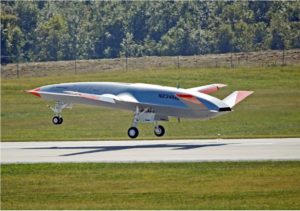The Navy’s top acquisition official expressed confidence in the Boeing [BA] MQ-25A Stingray unmanned carrier tanker program after a recent visit to the test asset, noting production of the first units will start soon.
Assistant Secretary of the Navy for Research, Development and Acquisition James Geurts told reporters during a press call today that he visited the MQ-25 team and the test vehicle, T-1, during a visit to St. Louis on July 28.

“I got to go see the MQ-25 test vehicle, it’s got the pod loaded on, it’s kind of in its final preflight – so it’ll start its next series of tests. And again, continuing to drive to the future of naval aviation, a key asset there and was good to see that and talk to the team,” Geurts said.
Last week, the Boeing MQ-25 team said it recently installed a Navy aerial refueling store on T-1 in preparation for additional flight tests. This is the same refueling store used by F/A-18s to perform aerial refueling off of aircraft carriers. The company did not specify when testing would resume, only saying it would occur later this year (Defense Daily, July 24).
The Navy aims to use the Stingray to allow F/A-18s in the refueling role to switch back to standard combat roles.
Geurts said he sees the Stingray problem through four lenses: flight testing, design maturity, ground control integration, and part of a larger unmanned network.
He argued the T-1 is a good example of the Navy team taking advantage of an opportunity to use a test asset, fly with it, get lessons learned, and figure out various facets of the program.
Geurts explained recently the team wanted to install some instrumentation in the T-1 engine, maintainers told him about how they did a full engine drop with restrictions like it was on a carrier.
“They were doing it just like you do on a carrier and looking at footprint because they do it all within the footprint of the airplane…we found a couple things about it – ok we have got to adjust procedures here and there.”
“That is a tremendous asset that the team has actually been double downing on how to reduce risk in the program. So getting it back up in the air with the refueling pod and doing more flight testing earlier I think is of great benefit to the program, looking forward to that,” Geurts continued.
Boeing conducted the first flight test of T-1 last September (Defense Daily, Sept. 20, 2019).
Geurts also said they are working their way through MQ-25 design maturity and “we’re on a good position now to going to start the production of the EMD (engineering and manufacturing development) assets, so I feel pretty confident on that.”
The Navy and Boeing are conducting tests on E-1 for early learning and discovery while the company works on the EMD model of the MQ-25.
Last year, Boeing said using the T-1 for up to 18 months with an embedded Navy program office on site aims to help speed up the initial operational capability of the MQ-25 (Defense Daily, April 29, 2019).
The company said that turns into 18 months of early learning rather than waiting through that time for the first EMD models.
Geurts said ground control station integration and modifications to carriers is a “continued work in progress.”
He admitted that trying to get carrier control station integration timing right with their availabilities “is always a challenge as carriers go through their cycles. And so that’s an area, again, of continued focus and challenge.”
In January, a Navy official said they are gradually installing Unmanned Aviation Warfare Centers (UAWCs) on carriers as they go through maintenance and overhaul periods. UAWC changes entail repurposing ship space for a control room to send and receive data from unmanned systems (Defense Daily, Jan. 22).
However, a June Government Accountability Office report warned the MQ-25 development schedule could be delayed by up to three years with a cost increase if the Navy misses any of its planned installation windows on carriers (Defense Daily, June 4).
Geurts also emphasized the MQ-25 will be part of a larger Navy network of unmanned assets.
“We’ve got a really large campaign going on right now of how do we really integrate all of these unmanned assets – under the water, on the water, above the water, holistically across the fleet and this is going to be one of the first major systems out there. And so we’re now we’re also weaving that into this larger unmanned campaign plan.”
He said the plan has all the facets of training on command and control, maintenance, control and data sharing.
“I think we’re cranking on, on the plan we have, and taking advantage of opportunities where we see it, and mitigating risk where those come up.”
Geurts cited one example of mitigating the unique risks of the COVID-19 pandemic.
He recounted a team is writing software for MQ-25 but dealing with that challenge of “you can’t get them all in the room in the way you originally planned. So adapt and overcome is a signature part of a high performing team and so I’m pretty impressed with it.”
Boeing is building the four EMD models under an $805 million contract awarded in 2018 (Defense Daily, Aug. 30, 2018).
In April, the Navy awarded Boeing an $85 million modification to procure three more MQ-25 system demonstration test articles (Defense Daily, April 3).